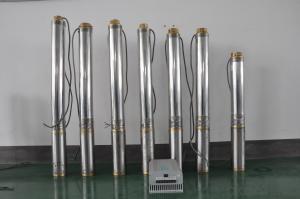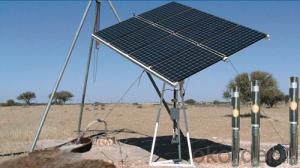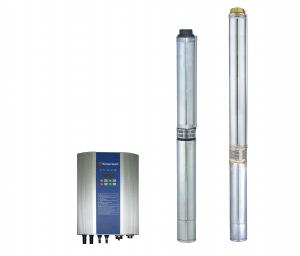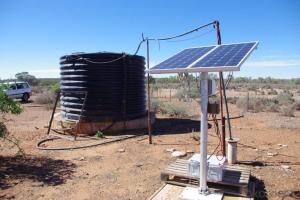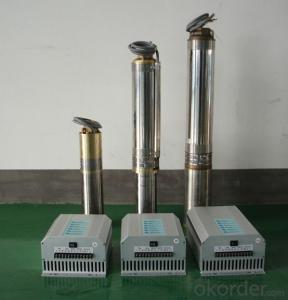Solar Water Pump 3DS-6-70
- Loading Port:
- China Main Port
- Payment Terms:
- TT OR LC
- Min Order Qty:
- -
- Supply Capability:
- 300 sets /month
OKorder Service Pledge
OKorder Financial Service
You Might Also Like
Product description:
Product: Solar water pump
Model:3DS-6
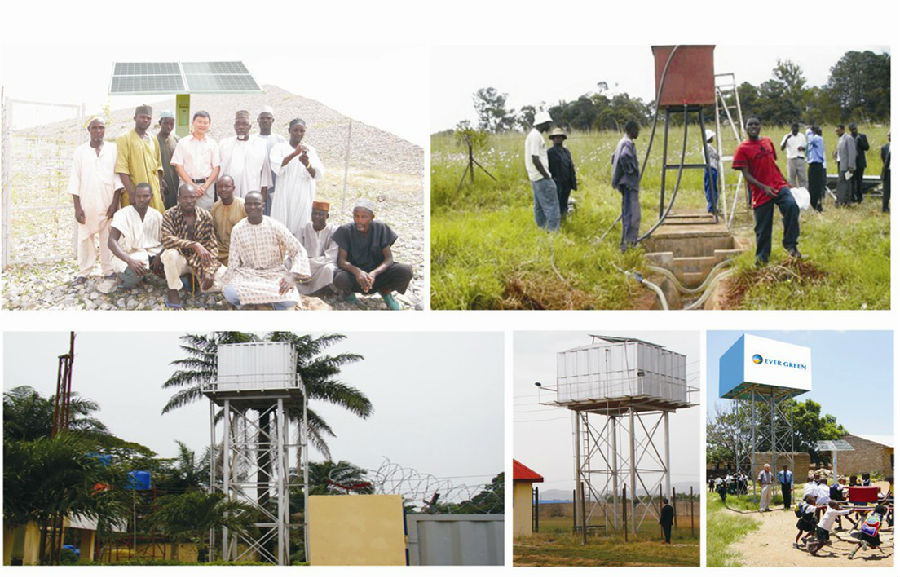 Appilication:
Appilication:
submersible pump
for deep well near a village or small farm
for drinking water of one village (100-300 people)
for watering a small farm
Product specification:
flow rate:1000 liter/ hour, 8000m3/day.
lift: 10m-70m
pump diameter: 140mm
well diameter more than 150mm
with BLDC motor, motor power:600W
but only need solar power:230W, our pump can save more than 50% solar panel power.
Material:
Pump inside: stainless steel and wearable nylon,it enables our solar pump to have 10 years sevice life.
Motor length:15cm,80% shorter than other motors. So that you can pump 80% more water by our solar pump.
Certification:
3 International patent
ISO9001
CE
Warranty:2 years
- Q:How does a solar pump handle water source contamination from sewage leaks?
- A solar pump does not have the ability to handle water source contamination from sewage leaks. It is primarily designed to harness solar energy to pump water from a source, but it does not have built-in mechanisms to filter or treat contaminated water. In case of sewage leaks or contamination, additional measures such as water treatment systems or filtration devices would be needed to ensure the water is safe for use.
- Q:Can a solar pump system be integrated with a smart home or automation system?
- Yes, a solar pump system can indeed be integrated with a smart home or automation system. The integration of these technologies allows for increased efficiency, convenience, and control over the solar pump system. By connecting the solar pump system to a smart home or automation system, users can remotely monitor and control the operation of the pump. This can be done through a smartphone application or a central control panel within the smart home system. Users can easily adjust the pump's settings, such as flow rate and timing, from anywhere with an internet connection. Moreover, the integration with a smart home or automation system enables the solar pump system to be synchronized with other devices and systems within the house. For example, the pump can be programmed to automatically turn on and off based on temperature or humidity levels, or it can be linked to a rainwater harvesting system to ensure efficient water usage. Additionally, integrating a solar pump system with a smart home or automation system allows for data monitoring and analysis. Real-time data, such as solar irradiance levels, water flow rate, and energy consumption, can be collected and analyzed to optimize the performance of the pump system. This information can be used to identify potential issues, track energy savings, and make informed decisions regarding maintenance or upgrades. In summary, integrating a solar pump system with a smart home or automation system offers numerous benefits, including remote control, synchronization with other devices, and data monitoring. This integration allows for a more efficient and convenient operation of the solar pump system, enhancing overall energy efficiency and sustainability in the smart home or automation setup.
- Q:How does the availability of sunlight affect the performance of a solar pump?
- The performance of a solar pump is directly impacted by the amount of sunlight available. Solar pumps rely on solar panels to convert sunlight into electricity, which then powers the pump. Therefore, the efficiency and productivity of the pump are determined by the quantity and intensity of sunlight. In regions where sunlight is abundant, the availability of sunlight ensures that the solar panels receive an optimal amount of energy to generate electricity. This leads to higher pump performance as more energy is available to power the pump, resulting in increased water flow rates and pumping capacity. On the other hand, in areas with limited sunlight or frequent cloudy weather, the performance of a solar pump may be negatively affected. The reduced availability of sunlight decreases the amount of energy produced by the solar panels, leading to lower pump performance. This can result in reduced water flow rates, decreased pumping capacity, and potentially inadequate water supply for irrigation, livestock, or other applications. It is important to note that solar pumps often have built-in mechanisms to cope with variations in sunlight availability. They may include energy storage systems, such as batteries, to store excess energy during sunny periods and utilize it during periods of low sunlight. This helps to maintain a more consistent and reliable pump performance even when sunlight is less available. In summary, the availability of sunlight is crucial in determining the performance of a solar pump. Regions with high solar irradiance generally benefit from more efficient and productive solar pumps, while areas with lower sunlight availability may experience reduced pump performance.
- Q:Can a solar pump be used in areas with high levels of sediment in water?
- Yes, a solar pump can be used in areas with high levels of sediment in water. However, it is important to note that frequent maintenance and proper filtration systems may be required to prevent clogging and damage to the pump.
- Q:Are there any maintenance requirements for the solar panels used in a solar pump system?
- Yes, there are maintenance requirements for the solar panels used in a solar pump system. Regular maintenance is essential to ensure the efficient functioning and longevity of the solar panels. Some common maintenance requirements include: 1. Cleaning: Solar panels can accumulate dust, dirt, leaves, and bird droppings over time, which can reduce their efficiency. Regularly cleaning the panels with water and a soft brush can help remove these contaminants and ensure optimal performance. 2. Inspection: Regularly inspecting the solar panels for any signs of damage, such as cracks, loose connections, or corrosion, is important. Any issues should be addressed promptly to avoid further damage or reduced efficiency. 3. Monitoring: Monitoring the performance of the solar panels regularly helps identify any abnormal behavior or drop in efficiency. This can be done by observing the output levels or using monitoring systems that provide real-time data on the panel's performance. 4. Shading: Ensuring that the solar panels are not shaded by trees, buildings, or other obstructions is crucial. Shading can significantly reduce the energy output, so trimming any overhanging branches or removing objects blocking sunlight is important. 5. Battery maintenance: If the solar pump system has a battery, it is essential to monitor and maintain the battery's health. This may involve checking the battery's charge levels, cleaning the terminals, and replacing the battery when necessary. 6. Professional servicing: It is recommended to have a professional inspect and service the solar pump system periodically. They can perform more advanced maintenance tasks, such as checking the inverter, testing the electrical connections, or evaluating the overall system performance. By following these maintenance requirements, solar panels used in a solar pump system can operate at their maximum potential and have a longer lifespan, ensuring consistent and reliable water pumping.
- Q:How does a solar pump handle water with high levels of ammonia or other pollutants?
- A solar pump can handle water with high levels of ammonia or other pollutants by incorporating a filtration system. This system helps remove or reduce the concentration of pollutants present in the water before it is pumped. The filtration process may involve various techniques such as activated carbon filters, reverse osmosis membranes, or other specialized methods depending on the specific pollutants. By effectively filtering the water, a solar pump ensures the delivery of cleaner and safer water for various purposes.
- Q:What is the maximum pumping capacity of a solar pump?
- The maximum pumping capacity of a solar pump can vary depending on the specific model and factors such as sunlight intensity and water source. However, solar pumps typically have a maximum pumping capacity ranging from a few hundred liters per hour to several thousand liters per hour.
- Q:What is the maximum depth a solar pump can reach?
- The maximum depth a solar pump can reach depends on various factors such as the power of the solar panels, the efficiency of the pump, and the quality of the water source. However, on average, solar pumps can typically reach depths of up to 100-200 feet.
- Q:Can a solar pump be used for water supply in off-grid cabins?
- Yes, a solar pump can be used for water supply in off-grid cabins. Solar pumps are powered by solar energy and can efficiently pump water from a well or other water sources to provide a reliable water supply in remote locations without access to electricity. They are a sustainable and cost-effective solution for off-grid cabins.
- Q:What is the installation process for a solar pump?
- The installation process for a solar pump typically involves the following steps: 1. Site Assessment: Determine the optimal location for the solar panels and pump system by considering factors such as sunlight exposure, water source proximity, and accessibility. 2. Mounting the Solar Panels: Install the solar panels in a location where they can receive maximum sunlight exposure, typically on a roof, ground-mounted rack, or pole mount. 3. Wiring and Connection: Connect the solar panels to the pump controller using appropriate wiring and connectors. Ensure proper polarity and secure connections to avoid any electrical issues. 4. Mounting the Pump: Install the pump in the desired location, ensuring it is securely anchored. Connect the pump to the water source, such as a well or water storage tank. 5. Installing the Pump Controller: Mount the pump controller near the solar panels, ensuring it is protected from harsh weather conditions. Connect the pump, solar panels, and batteries (if applicable) to the controller. 6. Testing and Commissioning: Test the system by turning on the pump and checking for proper functionality. Adjust settings on the pump controller, such as flow rate or pressure, as needed. 7. Maintenance and Monitoring: Regularly inspect and clean the solar panels to maintain their efficiency. Monitor the system's performance, including water flow, power generation, and battery charge (if applicable), to ensure optimal operation. It is important to note that the specific installation process may vary depending on the type and model of the solar pump system and local regulations. It is advisable to consult the manufacturer's installation guidelines or seek professional assistance for a successful installation.
1. Manufacturer Overview |
|
|---|---|
| Location | |
| Year Established | |
| Annual Output Value | |
| Main Markets | |
| Company Certifications | |
2. Manufacturer Certificates |
|
|---|---|
| a) Certification Name | |
| Range | |
| Reference | |
| Validity Period | |
3. Manufacturer Capability |
|
|---|---|
| a)Trade Capacity | |
| Nearest Port | |
| Export Percentage | |
| No.of Employees in Trade Department | |
| Language Spoken: | |
| b)Factory Information | |
| Factory Size: | |
| No. of Production Lines | |
| Contract Manufacturing | |
| Product Price Range | |
Send your message to us
Solar Water Pump 3DS-6-70
- Loading Port:
- China Main Port
- Payment Terms:
- TT OR LC
- Min Order Qty:
- -
- Supply Capability:
- 300 sets /month
OKorder Service Pledge
OKorder Financial Service
Similar products
New products
Hot products
Hot Searches
Related keywords









